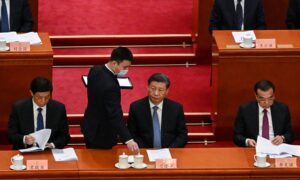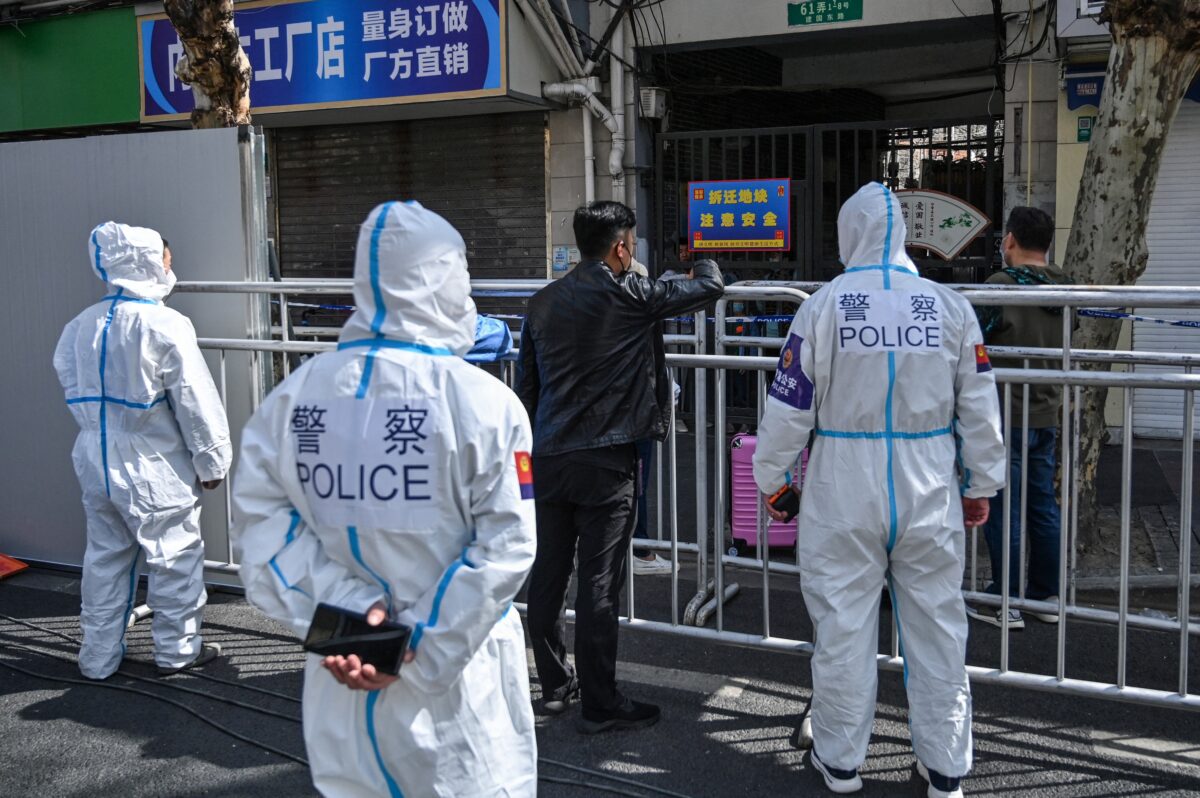Beijing’s Leadership Announces Its Goals
Commentary Earlier this month, Beijing hosted a huge crowd of Chinese officials. They were there for the “Two Sessions” gathering, which included some 3,000 delegates of the National People’s Congress (NPC), the country’s nominal legislature, and an additional 2,000 members of the Chinese People’s Political Consultive Conference (CPPCC), and advisory body. Though primarily a rubber stamp for the decisions of Chinese Communist Party (CCP) leader Xi Jinping and his allies chosen for leadership at last year’s 20th Party Congress, the announcements made in the past couple of weeks make clear the priorities and plans of China’s leadership. Xi stressed that all efforts would put people first, describing the people as the decisive force for building China. His people-centered philosophy, he insisted, includes all peoples and ethnic groups in China. Despite this predictable boilerplate, the plans he and his fellow speakers advanced placed their emphasis elsewhere—on the military and what could only be called the international contest for technological dominance. Announced goals for overall economic growth and development were modest by just about any standard. The government forecasts a 5.0 percent real growth this year and the creation of 12 million new urban jobs to bring the unemployment rate below 5.5 percent. Although this growth expectation is fast by the standards of most developed economies, it constitutes the acceptance by China’s leadership of a major slowdown in the pace of development. It is especially modest in the wake of three years in which the Chinese people suffered the lockdowns and quarantines associated with Beijing’s zero-COVID policy. Police and officials wearing protective gear work in an area where barriers are being placed to close off streets around a locked-down neighborhood in Shanghai on March 15, 2022. (Hector Retamal/AFP via Getty Images) Xi and company may even be setting things up for a need to revise expectations downward. This announced figure is already slower than the International Monetary Fund’s 5.2 percent real growth estimate for 2023. And the authorities are surely aware that their original 5.5 percent growth estimate for 2022 far exceeded the actual figure of 3.0 percent, a number that some independent sources claim overstate last year’s reality. However 2023 actually turns out, these projections reveal a chastened leadership in Beijing. Though Xi’s general comments spoke of the people’s needs, his specific economic plans seek less the kind of growth that everyday Chinese would appreciate and more about gaining a global advantage in technology. The delegates to the “Two Sessions” heard a great deal, for example, about artificial intelligence (AI), cloud computing, semiconductors, and hardware. The state planner, the National Development and Reform Commission (NDRC), said little about investments in consumer needs and much about a 50 percent jump in funds for chip development and related technologies, and increasing 5G base stations some 30 percent to 2.9 million by the end of the year. Beijing announced it is looking for foreign investment to help with chip development and the general push to advance Chinese technology. Premier Li Keqiang spoke of encouraging such investment flows by offering foreign investors “national treatment” and more freedom of action than in the past. Other than these general promises, however, his remarks offered few specifics. Given the growing suspicion of Beijing in Europe, the United States, and Japan, this part of the plan might be harder to achieve than expected. Hence, the technology goals are harder to realize. The sessions touched on green issues, but these remarks turned less on pollution and carbon dioxide emissions and almost exclusively on technological advances, especially energy independence. In other words, they are as much a part of China’s desire to outperform the West and, in time, do without its technological input than they are efforts to generally dial back greenhouse gases or pollution. Parallel to this single-minded focus on competitiveness was the clear emphasis on military matters. According to these meetings, Beijing plans to intensify its efforts to “complete national defense and military modernization by 2035.” It has budgeted a 7.2 percent boost in military spending this year. That figure exceeds the 5.7 percent overall growth in government spending, indicating another year in which the People’s Liberation Army will increase its share of the overall budget and the Chinese economy. The relative increase in military outlays extends the gap between Chinese defense spending and that of the next 13 Indo-Pacific countries combined. Clearly, Beijing plans to continue challenging the United States and its allies in the western Pacific. Premier Li did, however, offer a welcome note of conciliation. He spoke of China’s reunification with Taiwan but stressed the “peaceful development of cross-Strait relations.” Asid

Commentary
Earlier this month, Beijing hosted a huge crowd of Chinese officials. They were there for the “Two Sessions” gathering, which included some 3,000 delegates of the National People’s Congress (NPC), the country’s nominal legislature, and an additional 2,000 members of the Chinese People’s Political Consultive Conference (CPPCC), and advisory body.
Though primarily a rubber stamp for the decisions of Chinese Communist Party (CCP) leader Xi Jinping and his allies chosen for leadership at last year’s 20th Party Congress, the announcements made in the past couple of weeks make clear the priorities and plans of China’s leadership.
Xi stressed that all efforts would put people first, describing the people as the decisive force for building China. His people-centered philosophy, he insisted, includes all peoples and ethnic groups in China. Despite this predictable boilerplate, the plans he and his fellow speakers advanced placed their emphasis elsewhere—on the military and what could only be called the international contest for technological dominance.
Announced goals for overall economic growth and development were modest by just about any standard. The government forecasts a 5.0 percent real growth this year and the creation of 12 million new urban jobs to bring the unemployment rate below 5.5 percent. Although this growth expectation is fast by the standards of most developed economies, it constitutes the acceptance by China’s leadership of a major slowdown in the pace of development. It is especially modest in the wake of three years in which the Chinese people suffered the lockdowns and quarantines associated with Beijing’s zero-COVID policy.

Xi and company may even be setting things up for a need to revise expectations downward. This announced figure is already slower than the International Monetary Fund’s 5.2 percent real growth estimate for 2023. And the authorities are surely aware that their original 5.5 percent growth estimate for 2022 far exceeded the actual figure of 3.0 percent, a number that some independent sources claim overstate last year’s reality. However 2023 actually turns out, these projections reveal a chastened leadership in Beijing.
Though Xi’s general comments spoke of the people’s needs, his specific economic plans seek less the kind of growth that everyday Chinese would appreciate and more about gaining a global advantage in technology. The delegates to the “Two Sessions” heard a great deal, for example, about artificial intelligence (AI), cloud computing, semiconductors, and hardware. The state planner, the National Development and Reform Commission (NDRC), said little about investments in consumer needs and much about a 50 percent jump in funds for chip development and related technologies, and increasing 5G base stations some 30 percent to 2.9 million by the end of the year.
Beijing announced it is looking for foreign investment to help with chip development and the general push to advance Chinese technology. Premier Li Keqiang spoke of encouraging such investment flows by offering foreign investors “national treatment” and more freedom of action than in the past. Other than these general promises, however, his remarks offered few specifics. Given the growing suspicion of Beijing in Europe, the United States, and Japan, this part of the plan might be harder to achieve than expected. Hence, the technology goals are harder to realize.
The sessions touched on green issues, but these remarks turned less on pollution and carbon dioxide emissions and almost exclusively on technological advances, especially energy independence. In other words, they are as much a part of China’s desire to outperform the West and, in time, do without its technological input than they are efforts to generally dial back greenhouse gases or pollution. Parallel to this single-minded focus on competitiveness was the clear emphasis on military matters.
According to these meetings, Beijing plans to intensify its efforts to “complete national defense and military modernization by 2035.” It has budgeted a 7.2 percent boost in military spending this year. That figure exceeds the 5.7 percent overall growth in government spending, indicating another year in which the People’s Liberation Army will increase its share of the overall budget and the Chinese economy. The relative increase in military outlays extends the gap between Chinese defense spending and that of the next 13 Indo-Pacific countries combined.
Clearly, Beijing plans to continue challenging the United States and its allies in the western Pacific. Premier Li did, however, offer a welcome note of conciliation. He spoke of China’s reunification with Taiwan but stressed the “peaceful development of cross-Strait relations.”
Aside from a few specifics, there was little new to come out of these otherwise important meetings. Xi avoided the stress he has in the past placed on centralized decision-making. Still, the economic and military emphasis of the meetings makes clear that the trend will continue and continue to serve military efforts, as well as other forms of competition with the West and its allies.
Meanwhile, Li’s otherwise welcome remarks on keeping the peace in the Taiwan Straits deserve a pinch of salt, given China’s recent bellicose actions in this area.
Views expressed in this article are the opinions of the author and do not necessarily reflect the views of The Epoch Times.












